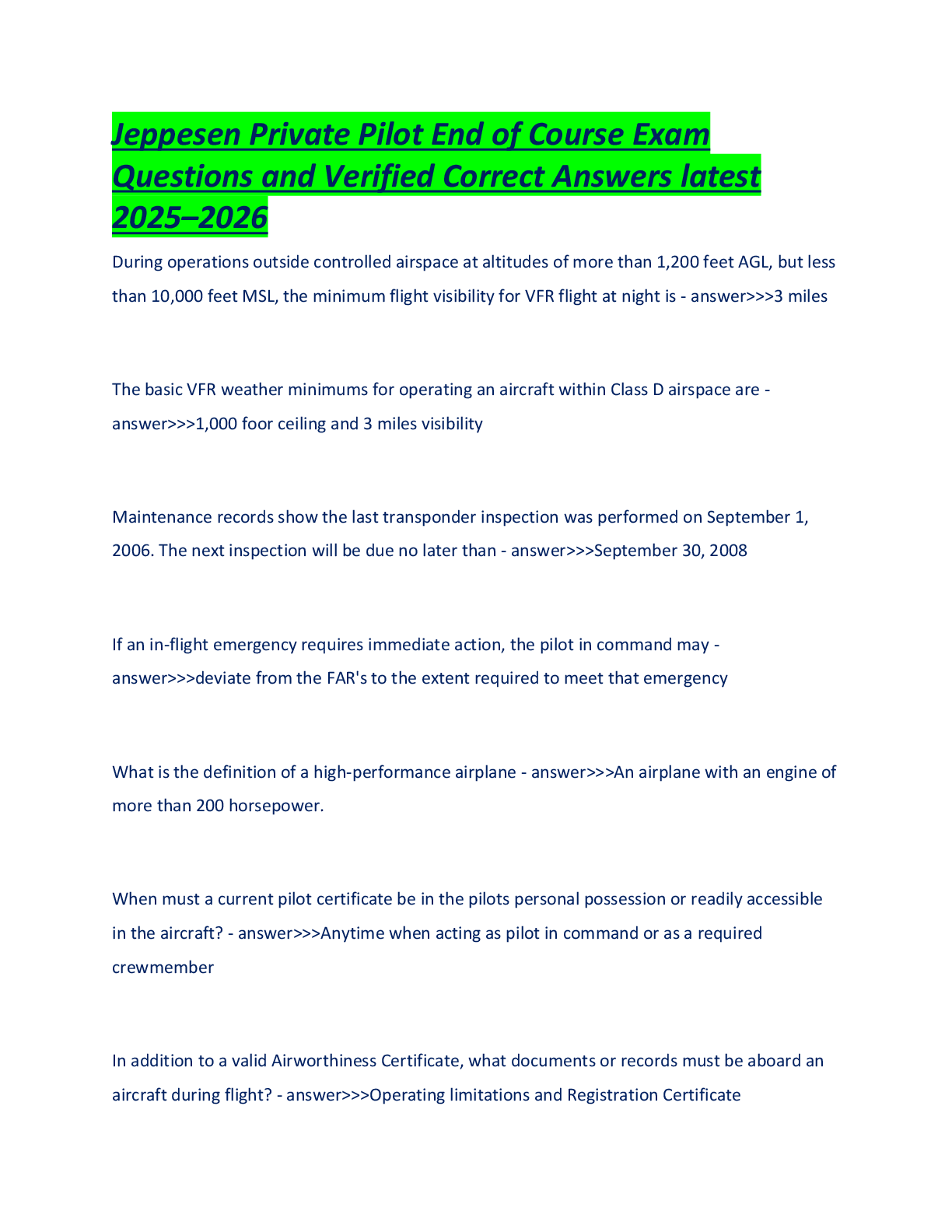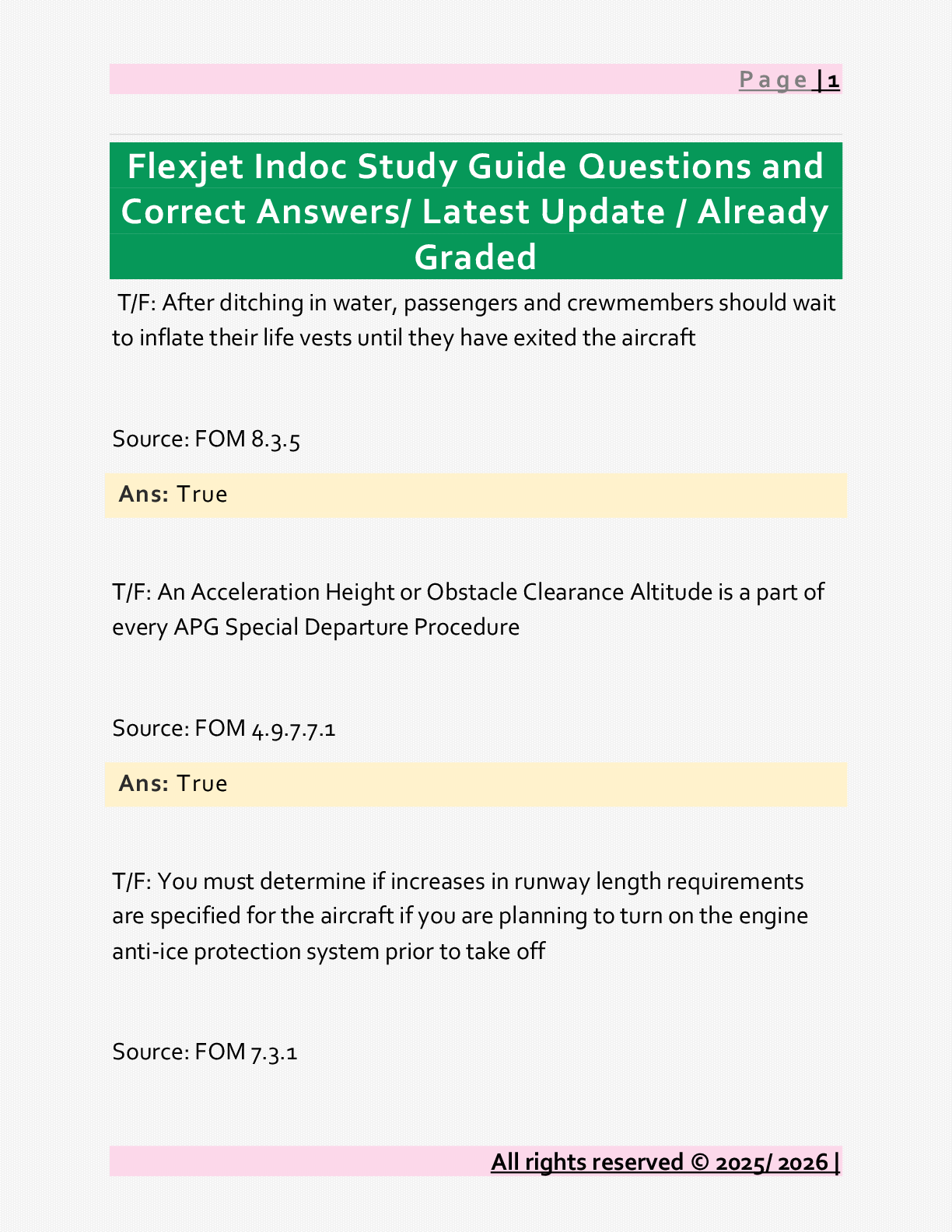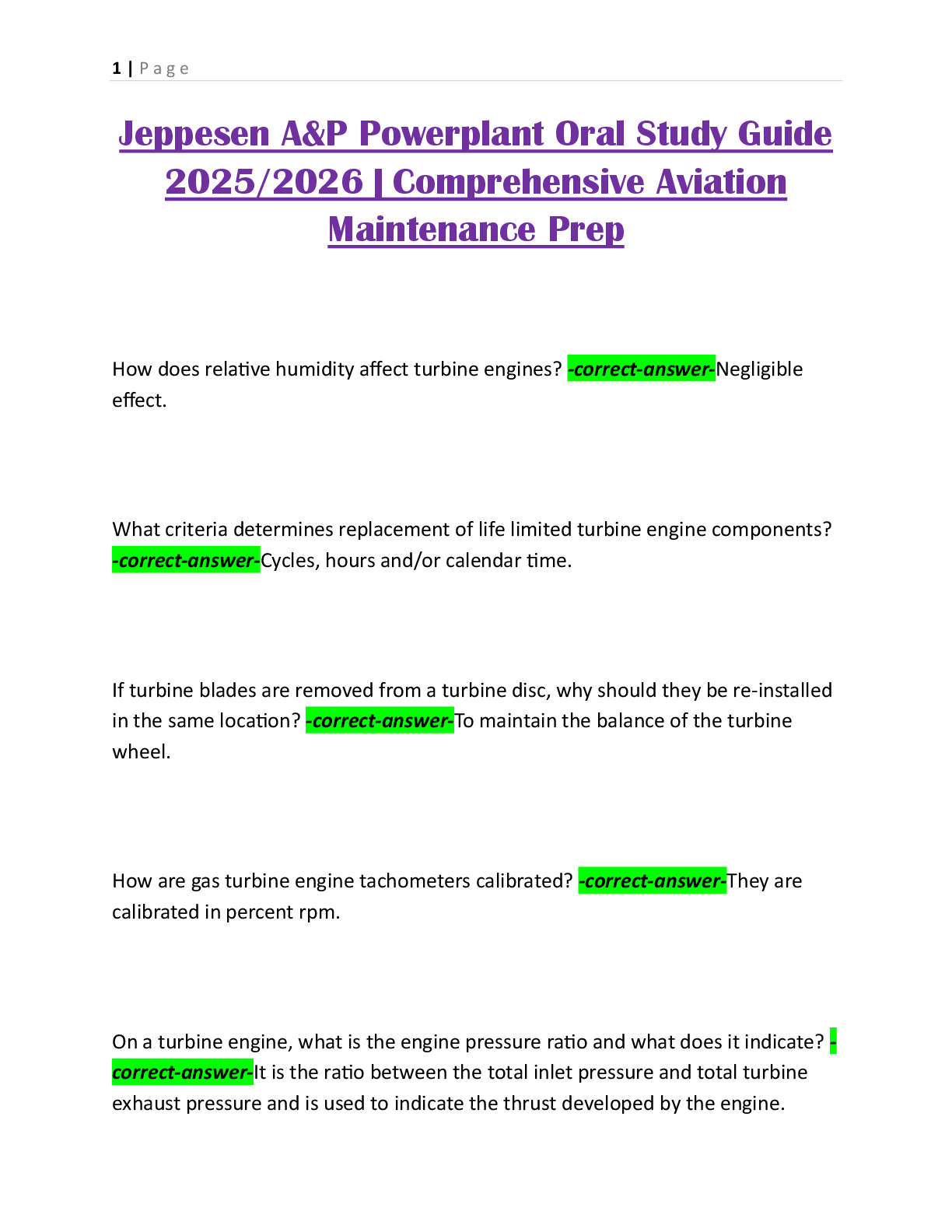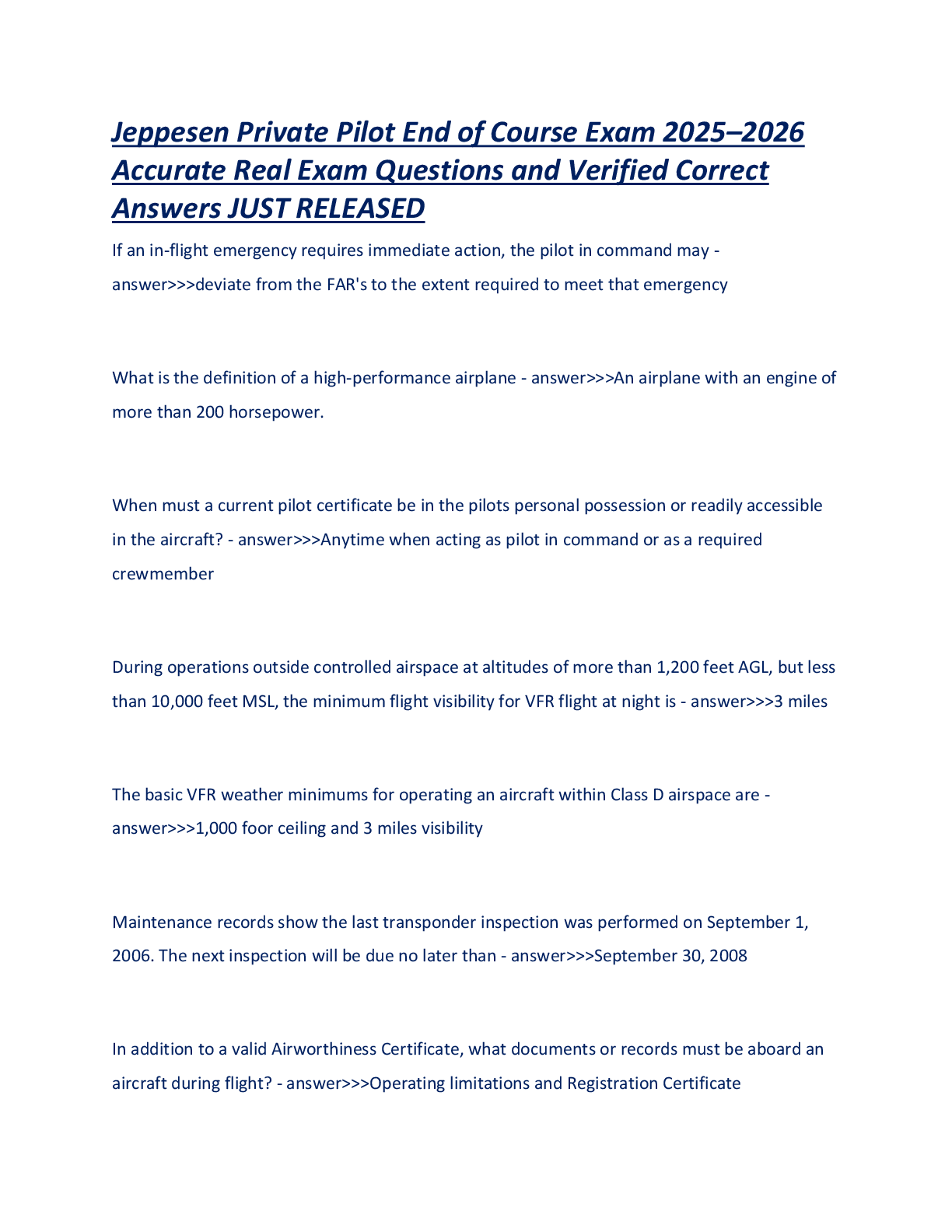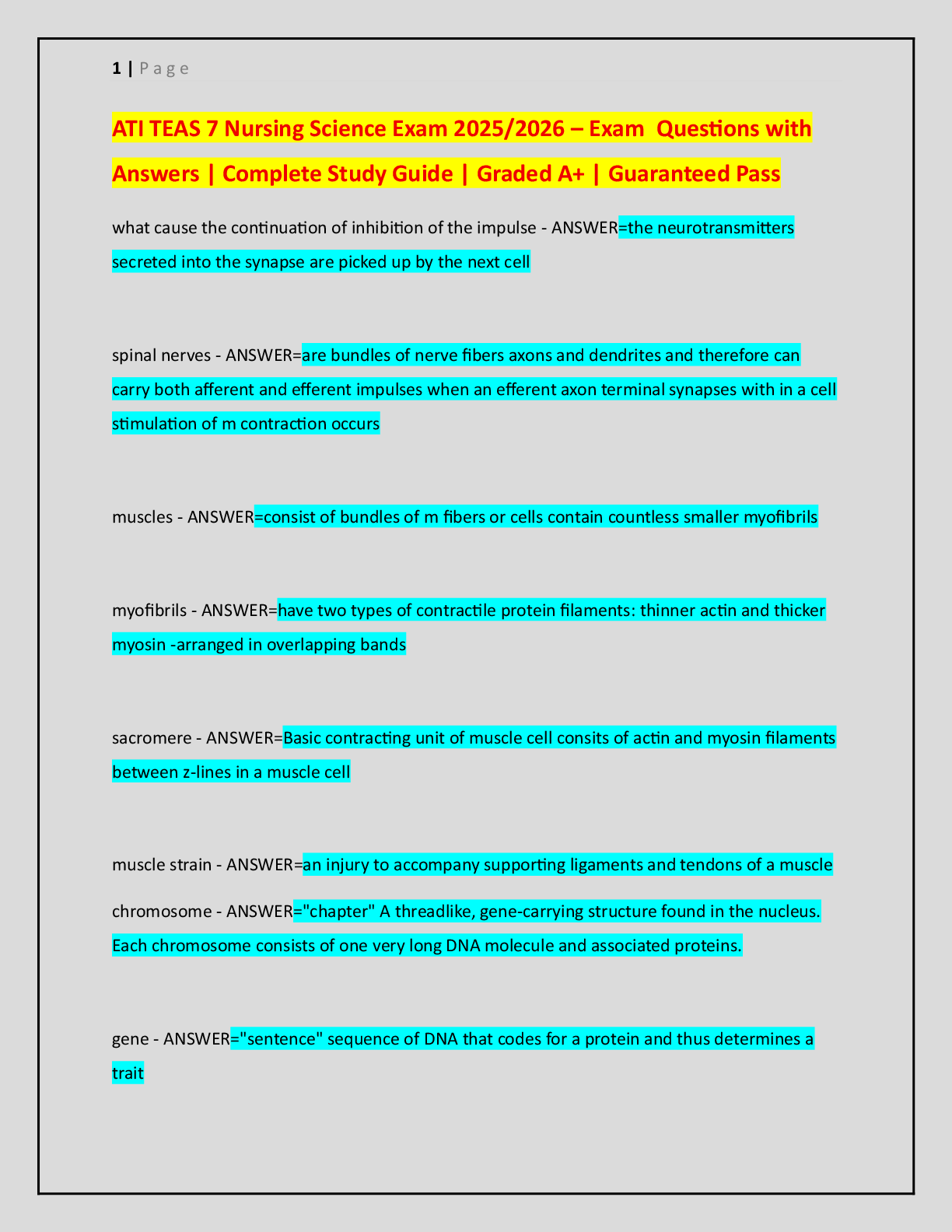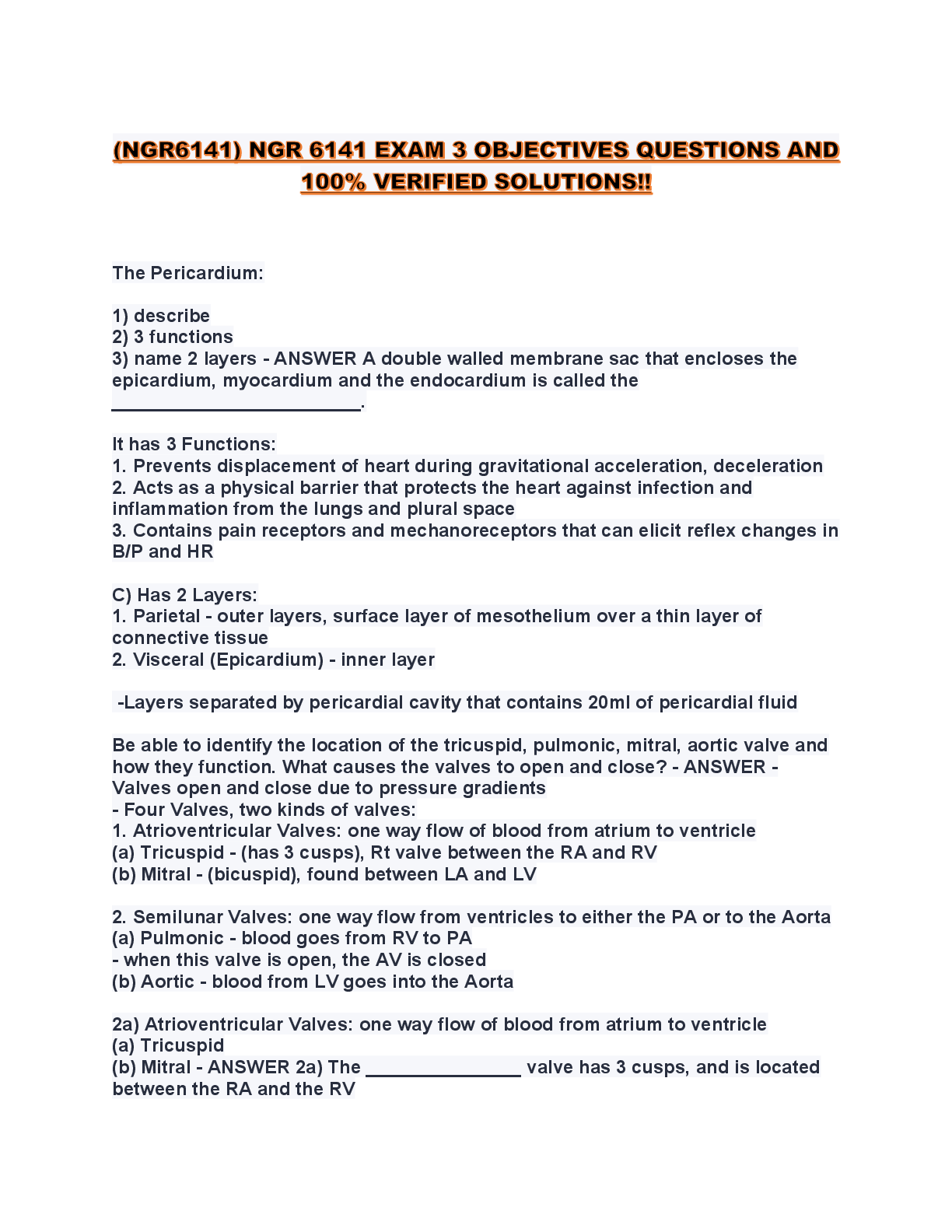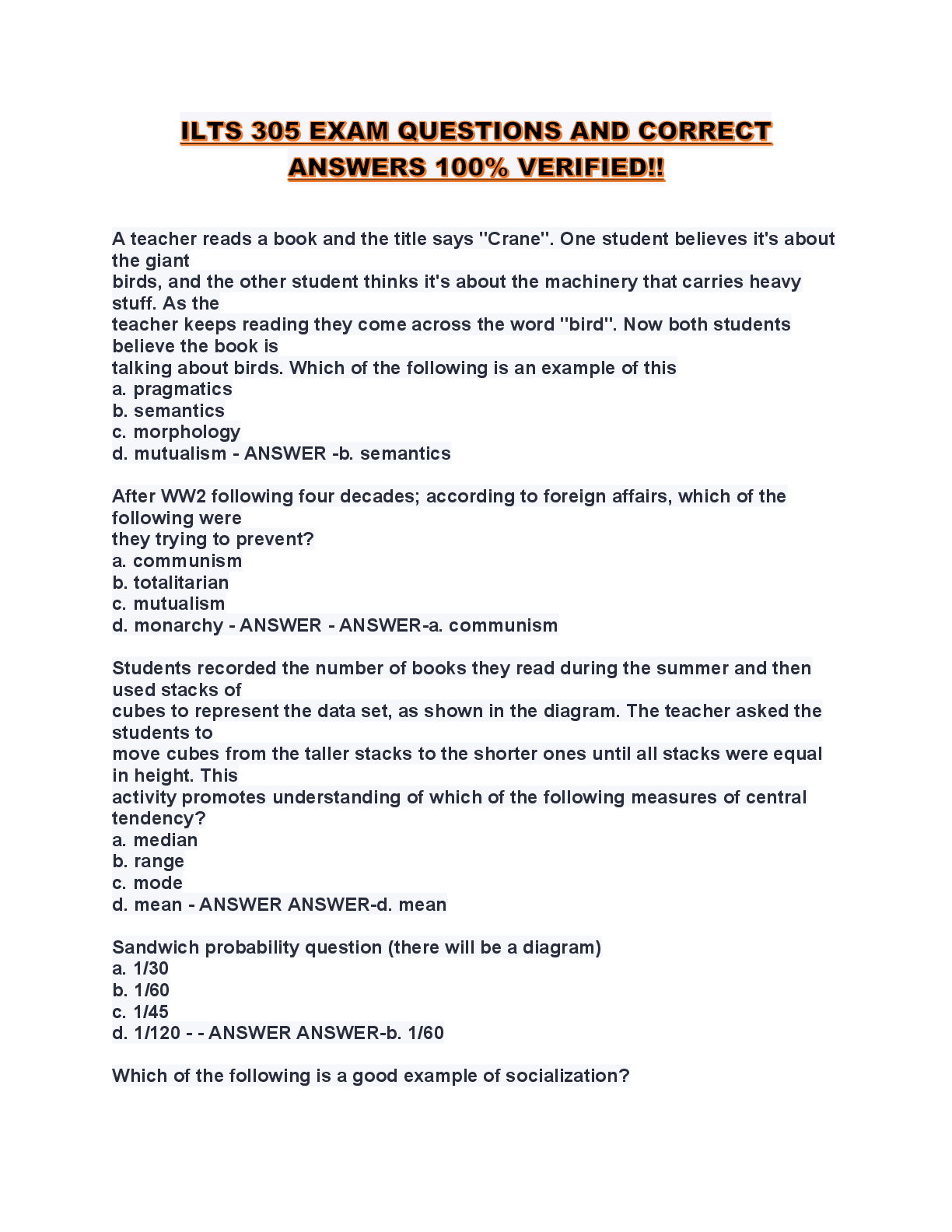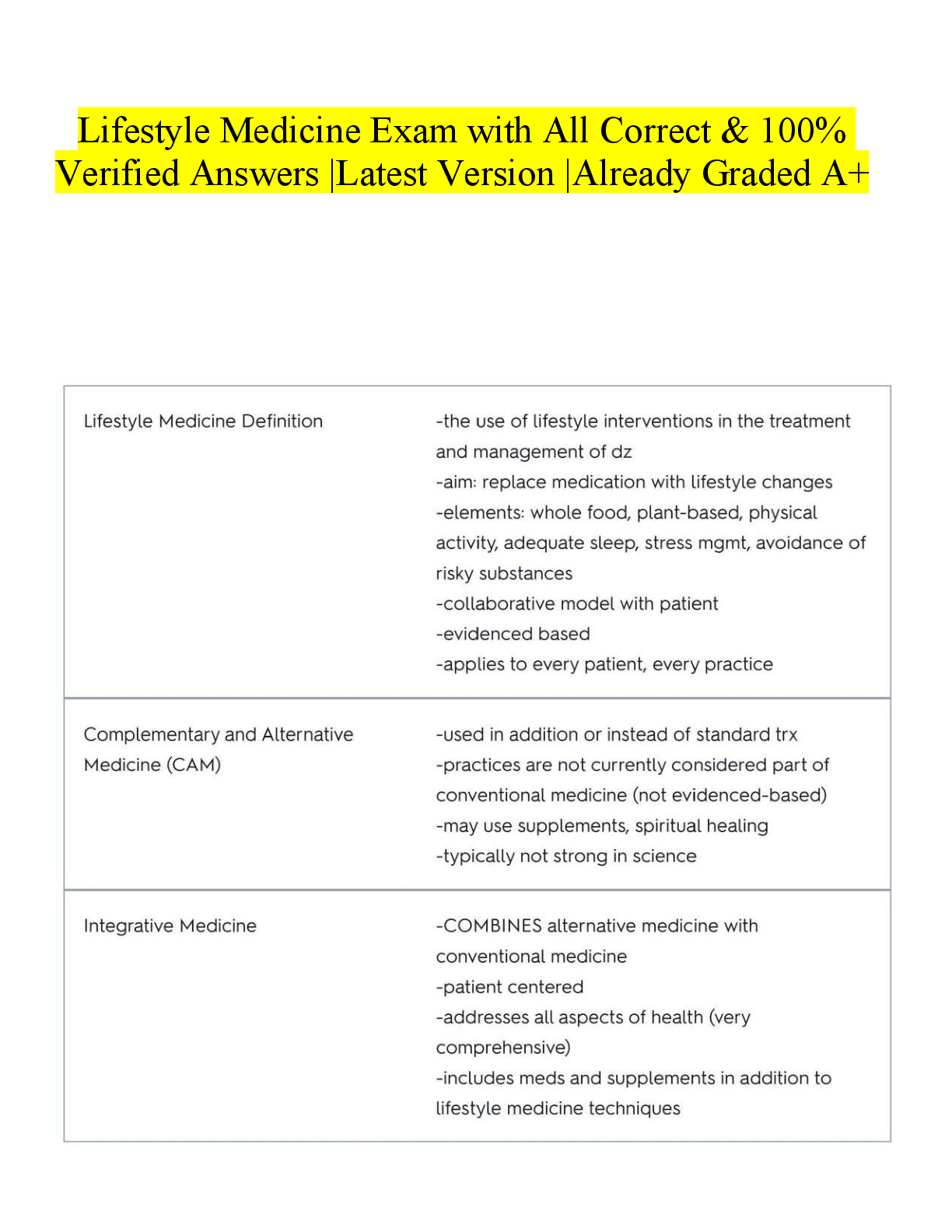exam 2 notes(GET GOOD SCORES)
Document Content and Description Below
Chapter 38: Oxygenation and Perfusion
Cardiopulmonary system: demand for oxygen is met by the function of the respiratory and cardiovascular system
Oxygen toxicity:
• Signs and symptoms of oxyg
...
en toxicity result from its effects on the central nervous system (CNS) and pulmonary system. CNS manifestations of oxygen toxicity include pallor, sweating, nausea, vomiting, seizures, muscle twitching, vertigo, tinnitus, hallucinations, visual changes, anxiety, respiratory changes, and decreased levels of consciousness. Pulmonary signs and symptoms of oxygen toxicity include substernal chest pain, shortness of breath, dry cough, and pulmonary edema or fibrosis.
• Oxygen toxicity can develop when the fraction of inspired oxygen (FiO2) is above 50% for longer than 24-48 hours. One of the early stages of oxygen toxicity is substernal chest pain. More oxygen might further damage the patient’s lungs
Anatomy and physiology of oxygenation
• Oxygenation of blood tissues depends on many factors
o Integrity of the airway system to transport air to and from the lungs
o It is important for alveolar system in the lungs to oxygenate venous blood and to remove CO2 from the blood
Anatomy of respiratory system
• Begins at nose and ends at terminal bronchioles is the transport and exchange of oxygen and CO2
• Upper airway is composed of: the nose, pharynx, larynx, and epiglottis.
o Main function: warm, filter, and humidify inspired air.
• Lower airway is composed of: he tracheobronchial tree, includes the trachea, right and left main stem bronchi, segmental bronchi, and terminal bronchioles
o Main function: conduction of air, mucociliary clearance, and production of pulmonary surfactant.
• Airways are lined with mucus
o Main function: trap cells, particles, and infectious debris, also helps protects underlying tissues from irritation and infection
• Cilia- microscopic hair-like projections,
o Main function- propel trapped material and accompanying mucus toward the upper airway so they can be removed by coughing.
o Removal is facilitated when mucus is watery in consistency
• Lungs are main organs of respiratory system. They are located in thoracic cavity. Lungs extend from diaphragm to the apex – above first rib. Heart lies between right and left lung
• Lungs are divided into lobes. Then subdivide into segments or lobules.
o Right lung has 3 lobes
o Left lung has 3 lobes
o Main bronchus branches to each lunch from the trachea
▪ Immediate subdivides into secondary bronchi one to each lobe
o The bronchi subdivide again and again becoming smaller and smaller as they branch through the lung
▪ The smallest of these branches are the bronchioles ending at terminal bronchioles
• Lungs are composed of elastic tissues that can stretch or recoil
• Alveoli (Alveolus)- Small air sacs
o Site of gas exchange
o Alveolus is a single layer of squamous epithelium
• Surfactant- Detergent-like, reduces surface tension between the moist membranes of alveoli –preventing their collapse
o When surfactant production is reduced, the lung becomes stiff and alveoli collapse
• Lungs and thoracic cavity are lined with serous membrane
o Visceral pleura covers lungs
o Parietal pleura lines thoracic cavity
▪ These are continuous and form a closed sac
o Pleural fluid between the membranes acts as a lubrication and as an adhesive agent to hold the things in an expanded position
• Pressure within the pleural space (interpleural pressure) is subatmospheric (a negative pressure)
o Holds the lining in an expanded position Physiology of respiratory system
• Gas exchange, the intake of oxygen and the release of carbon dioxide, is made possible by pulmonary ventilation, respiration, and perfusion.
• Pulmonary ventilation- the movement of air into and out of the lungs. (breathing) Has two process
o Inspiration (Inhalation)
▪ The active phase, involves movement of muscles of the thorax to bring air into lungs
▪ The diaphragm contacts and descends, and lengthening the thoracic cavity, external intercostal muscles contact, ribs lift upward and outward.
▪ Combination of an increase lung volume and decreased intrapulmonic pressure allow atmospheric air to
move from an area of greater pressure (outside air) into an area of lesser pressure (within the lungs).
▪ The relaxation, or recoil, of these structures then results in expiration.
o Expiration (exhalation)
▪ Passive phase, movement oh air out of the lungs
▪ The diaphragm relaxes and moves up, the ribs move down, and the sternum drops back into position.
▪ This causes a decreased volume in the lungs and an increase in intrapulmonic pressure.
▪ As a result, air in the lungs moves from an area of greater pressure to one of lesser pressure and is expired
• Perfusion- oxygenated capillary blood passes through body tissues.
• Lung compliance refers to the ease with which the lungs can be inflated
o Compliance of lung tissue affects lung volume
o The ability of the lungs to adequately fill with air during inhalation is achieved by the normal elasticity of lung tissue, aided by the presence of surfactant.
• Airway resistance is the result of any impediment or obstruction that air meets as it moves through the airway.
• Any process that changes the bronchial diameter or width causes airway resistance.
Respiration
• Respiration- Gas exchange
o Occurs at the terminal alveolar capillary system
o Exchanged between the air and blood via dense network of capillaries in the respiratory portion of lungs and the thin alveolar walls
o Occurs via diffusion
• Diffusion- is the movement of gas or particles from areas of higher pressure or concentration to areas of lower pressure or concentration.
o In respiration, diffusion refers to the movement of oxygen and carbon dioxide between the air (in the alveoli) and
the blood (in the capillaries).
o These gases move passively from an area of higher concentration to an area of lower concentration.
o Diffusion of gases in the lung is influenced by several factors, including changes in surface area available, thickening of alveolar–capillary membrane, and partial pressure.
• Atelectasis- Incomplete lung expansion or the collapse of alveoli,
o Prevents pressure changes and the exchange of gas by diffusion in the lungs.
o Cannot fulfil the function of respiration
o Ex) obstructed airways, mucus, airway constriction, external compression by tumors or enlarged blood vessels and immobility
• When oxygen is administered, an increase amount of oxygen is available resulting diffusion across capillary membranes
Perfusion
• Perfusion- Oxygenated capillary blood passes through the tissues of the body
• The amount of blood present in any given area of lung tissue depends partially on whether the person is sitting, standing, or lying down.
• Perfusion is greater in dependent areas
• The perfusion of lung tissue also depends on the person’s activity level.
o Greater activity results in an increased need for cellular oxygen by the body’s tissues and a subsequent increase in cardiac output and consequently in increased blood return to the lungs.
• Also depends on blood supply and proper cardiovascular functioning to carry O2 and CO2 to and from lungs
Regulation of the respiratory system
• The respiratory center is located in the medulla in the brainstem
• It is stimulated by an increased concentration of carbon dioxide and hydrogen ions and, to a lesser degree, by the decreased amount of oxygen in the arterial blood.
• Stimulation of the medulla increases the rate and depth of ventilation (both inspiration and expiration) to blow off car- bon
dioxide and hydrogen and increase oxygen levels (the patient is breathing faster and more deeply).
Alterations in respiratory function
• Hypoxia- Condition in which an inadequate amount of oxygen is available to cell
o Symptoms: Dyspnea (difficult breathing), an elevated blood pressure with a small pulse pressure, increased respiratory and pulse rates, pallor, and cyanosis. Anxiety, restlessness, confusion, and drowsiness
o Hypoxia is often caused by hyperventilation (decreased rate or depth of air movement into the lungs)
o Can be a chronic condition – detected in all body systems
▪ headaches, chest pain, enlarged heart, clubbing of the fingers and toes, anorexia, constipation, decreased urinary output, decreased libido, weakness of extremity muscles, and muscle pain.
Cardiovascular system
• Oxygen and carbon dioxide must move through the alveoli and be carried to and from body cells by the blood.
• The cardiovascular system is composed of the heart and blood vessels
• Heart is the main organ of circulation
o Circulation- the continuous, one-way circuit of blood through the blood vessels with the heart as the pump
• Heart is a cone shaped, muscular pump divided into four hollow chambers
o Upper chamber- The atria receives blood from the veins (superior and inferior vena cava and the left/right pulmonary veins
o Lower chamber- the ventricles force blood out of the heart through the arteries (left/right pulmonary arteries and
aorta)
o One-way valves that direct blood flow through the heart are located at the entrance (tricuspid and mitral valves) and exit (pulmonary, and aortic valves) of each ventricle.
• Arteries and arterioles conduct blood away from the ventricles to the capillaries and the venules and veins, and return blood
from the capillaries to the atria.
Physiology of the cardiovascular system
• Blood is squeezed through the heart into the body by contractions starting in the atria, followed by contraction of the ventricles, with a subsequent resting of the heart.
• Deoxygenated blood (low in oxygen, high in carbon dioxide) is carried from the right side of the heart to the lungs, where
oxygen is picked up and carbon dioxide is released, and then returned to the left side of the heart.
• This oxygenated blood (high in oxygen, low in carbon dioxide) is pumped out to all other parts of the body and back again
• The quantity of blood forced out of the left ventricle with each contraction is called the stroke volume (SV).
• The cardiac output (CO) is the amount of blood pumped per minute in a heathy adult
o CO=SV X HR
o Cardiac output increases during physical activity and decreases during sleep; it also varies depending on body size and metabolic needs.
• Once the red blood cells reach the tissues, internal respiration must occur.
• Internal respiration is the exchange of oxygen and carbon dioxide between the circulating blood and the tissue cells.
• Anemia, a decrease in the amount of red blood cells or erythrocytes, results in insufficient hemoglobin available to transport oxygen
Regulation of the cardiovascular system
• Electrical impulses produced in and carried over specialized tissue within the heart control contraction of the muscles of the heart.
• SA (Sinoatrial Node) -This node initiates the transmission of electrical impulses, causing contraction of the heart at regular
intervals. It is also referred to as the pacemaker.
• The impulse also travels at the same time to the atrioventricular (AV) node, located at the bottom of the right atrium.
• A person’s heart rate can be modified by the nervous system based on the needs of the body.
o Sympathetic nerves increase heart rate and force contraction in response to increase activity and as part of the response to real or perceived threat
o Parasympathetic stimulation of the SA and AV nodes by the vagus nerve decreases the heart rate.
Alterations in cardiovascular function
• Dysrhythmia- (arrhythmia) is a disturbance of the rhythm if the heart
o Caused by an abnormal rate of electrical impulse generation from the SA node of from impulse originating from a site or sites other than the SA node
o Can occur from heart disease, HTN, damage from the heart, presence of various drugs, with decreased oxygenation
of the heart tissue and with trauma
o Dysrhythmias cause disturbances of the heart rate, heart rhythm, or both, and can affect the pumping action of the heart, interfering with circulation, leading to alterations in oxygenation.
• Myocardial ischemia- decreased oxygen supply to the heart caused by insufficient blood supply, can lead to impaired
oxygenation of tissues in the body.
o It is most commonly caused by atherosclerosis, (the accumulation of fatty substances and fibrous tissue in the lining of arterial blood vessel walls, ) creating blockages and narrowing the vessels, reducing blood flow.
o Causes disturbances of the heart rate, heart rhythm, or both, and can affect the pumping action of the heart,
interfering with circulation, leading to alterations in oxygenation.
• Stable angina- temporary imbalance between the amount of oxygen needed by the heart and the amount delivered to the heart muscles
• Myocardial infarction- Death of heart tissue due to lack of oxygen, also known as a heart attack
• Heart failure- unable to pump a sufficient blood supply, resulting in inadequate perfusion and oxygenation of tissue
o Chronic HTN, coronary artery disease, and disease of heart valves,
o Symptoms include SOB, edema, and fatigue,
Factors affecting cardiopulmonary functioning and oxygenation
• Renal or cardiac disorders often have compromised respiratory functioning because of fluid overload and impaired tissue perfusion.
• People with chronic illnesses often have muscle wasting and poor muscle tone.
• Anemia can result in impaired respiratory function.
o Anemia may lead to an inadequate supply of oxygen to the tissues of the body
o Because hemoglobin also carries carbon dioxide to the lungs, anemia results in diminished carbon dioxide exchange.
• Research reveals a statistically significant correlation between obesity and chronic bronchitis.
o Moreover, people who are obese are often short of breath during activity, ultimately leading to less participation in exercise.
Developmental considerations Infants
• Chest is small, airways are short and aspiration is a potential problem.
• Respiration rate is rapid 30-55 breaths/min
• As alveoli increase in number and size, adequate oxygenation is accomplished as lower respiration rates
• Surfactant is formed in utero between 34 and 36 weeks
o An infant born before 34 weeks may not have produced sufficient surfactant, leading to collapse of the alveoli and poor alveolar exchange.
o Synthetic surfactant can be given to the infant to help reopen the alveoli.
Toddlers, Preschoolers, school-aged children, and adolescents
• The preschool child’s Eustachian tubes, bronchi, and bronchioles are elongated and less angular.
o Average number of routine colds and infections decreases until the child enters daycare or school and is exposed more frequently to pathogens.
o Most children develop colds and upper respiratory infections. Some develop ear infections, bronchitis, and
pneumonia. Also at risk for asthma as a result of second hand smoke
• At end of childhood during adult hood, the immune system is prepared for the person from most infections
Older adults
• The tissues and airways of the respiratory tract (including the alveoli) become less elastic.
• The power of the respiratory and abdominal muscles is reduced, therefore the diaphragm moves less efficiently.
• The chest is unable to stretch as much, resulting in a decline in maximum inspiration and expiration.
• Airways collapse more easily. These alterations increase the risk for disease, especially pneumonia and other chest infections.
Medications
• Opioids can result in decreased respiratory and heart rate
o Watch for possibility of respiratory depression or arrest when administering any narcotic or sedative
Lifestyle considerations
• sedentary activity patterns do not encourage the expansion of alveoli and the development of pulmonary exercise patterns ( deep breathing)
• Regular physical activity pro- vides many health benefits, including increased heart and lung fitness, improved muscle
fitness, and reducing the risk of heart disease.
• Cigarette smoking is the most important risk factor for chronic COPD. Smoking cause coronary heart disease, the leading cause of death in the United States.
• Researchers have determined a high correlation between air pollution and cancer and lung disease
• Hyperventilation- increased rate and depth of ventilation above the body’s normal metabolic requirements
o Can lead to lowered levels of arterial carbon dioxide
o Anxiety can produce bronchial asthma
o Some patients with respiratory problems often develop some anxiety as a result of the hypoxia cause by the respiratory problems
Nursing History
• Important step of the nursing process
o Always includes cardiopulmonary component
• Include data about why the patient needs nursing care and what kind of care is required to maintain sufficient oxygenation of tissue
• Interview questions: help identify current or potential health deviations, identify any contributing factors, the use of any
aids to improve oxygenation, and effects of health problems on the patient’s lifestyle and relation- ships with others.
• When a health deviation is noted during the data col- lection, collect as much descriptive information as possible including whether the problem evolved rapidly or slowly
Inspection
• Pallor- Lack of color to skin or mucous membranes indicates less than optimal oxygenation
• Cyanosis- bluish discoloration
o Indicates decreased blood flow or poor blood oxygenation
• The adult chest contour is slightly convex, with no sternal depression. The anteroposterior diameter should be less than the transverse diameter. Intercostal spaces should be flat or depressed and the movement of chest should be symmetrical. Respiratory rate should be 12-20
• Kyphosis- curvature of the spine
o contributes to the older person’s appearance of leaning forward and can limit respiratory ventilation.
• Barrel chest deformity may be a result of aging or COPD
• Tachypnea- Rapid breathing
• Bradypnea- slow breathing
o Suggests health deviation
Palpation
• Abnormal size or location of the PMI or the presence of vibrations can indicate heart failure, myocardial infarction, disease of the heart valves, or other cardiac diseases.
• Note the presence or absence of edema, or tenderness on palpation. The presence of decreased skin temperature, pallor,
cyanosis, decreased pulses, and prolonged capillary refill can indicate less than optimal cardiac function and oxygenation.
• The presence of edema an also indicate alterations in cardiovascular function.
Percussion
• Percussion is used to assess the position of the lungs, density of lung tissue, and identify changes in the tissue.
o Not used frequently
o Included in examination and performed by advanced practice nurses
Auscultation
• Assesses air flow through the respiratory passages and lungs.
• Listen for normal and abnormal lung sounds.
• Normal breath sounds include vesicular (low-pitched, soft sounds heard over peripheral lung fields),
• bronchial (loud, high-pitched sounds heard primarily over the trachea and larynx),
• Broncho vesicular (medium-pitched blowing sounds heard over the major bronchi)
• Auscultate as the patient breathes slowly through an open mouth. Breathing through the nose can produce falsely abnormal breath sounds.
• adventitious sounds (extra, abnormal sounds of breathing)
• Abnormal lung sounds can occur as a result of alterations in the respiratory and cardiovascular systems and lead to impaired oxygenation.
• Crackles- frequently heard on inspiration, are soft, high-pitched discontinuous (intermittent) popping sounds.
o They are produced by fluid in the airways or alveoli and delayed reopening of collapsed alveoli. They occur due to inflammation or congestion and are associated with pneumonia, heart failure, bronchitis, and COPD.
• Wheezes are continuous musical sounds, produced as air passes through airways constricted by swelling, narrowing,
secretions, or tumors. They are often heard in patients with asthma, tumors, or a buildup of secretions.
Nursing Diagnosis
• After the assessment is completed and the data are examined, the nurse concludes either that there is no problem at this time or that there is an actual or potential oxygenation problem that is amenable to independent or interdependent nursing actions.
• Examples of nursing diagnoses are
o Ineffective airway clearance
o Decreased cardiac output
o Impaired gas exchange
o Activity Intolerance related to imbalance between oxygen supply and demand
o Anxiety related to feeling of suffocation
o Fatigue related to impaired oxygen transport system
o Imbalanced Nutrition: Less Than Body Requirements, related to difficulty breathing
o Disturbed Sleep Pattern related to orthopnea and bronchodilators
Outcomes for nursing diagnosis
• Demonstrate improved gas exchange in the lungs by an absence of cyanosis or chest pain and a pulse oximetry reading more than 95%
• Relate the causative factors, if known, and demonstrate a method of coping with these factors
• Preserve cardiopulmonary function by maintaining an optimal level of activity
• Demonstrate self-care behaviors that provide relief from symptoms and prevent further cardiopulmonary problems
Implementing
• Nursing interventions related to oxygenation aim to promote optimal functioning of the cardio- pulmonary systems, to promote comfort, and to promote and control coughing. Nurses may also need to intervene by performing chest physiotherapy, suctioning the airway, meeting respiratory needs with medications, providing supplemental oxygen, managing chest tubes, using artificial airways, clearing an obstructed airway, and administering CPR.
Promoting optimal function
• Vaccination is an important part of preventing respiratory infections
• Teach about pollution free environments
• It is important to minimize anxiety in patients with alterations in oxygenation in order to promote optimal functioning
• Promote good nutrition Healthy lifestyle
• Patients who practice good health behaviors can reduce their risk for many cardiopulmonary disease
o Should be incorporated into daily and weekly activity
• Eat healthy diet and maintain healthy weight
Vaccinations Influenza
• All people 6 months of age and older should be vaccinated each year
Pneumococcal disease
• There are different types of pneumococcal disease, such as pneumococcal pneumonia, meningitis, and otitis media.
• Pneumococcal disease can be fatal.
• In some cases, it can result in long-term problems, like brain damage, hearing loss, and limb loss.
• Pneumococcal vaccine is very good at preventing severe disease, hospitalization, and death. Pneumococcal vaccine is recommended for all children less than 59 months of age.
• Children aged more than 24 months who are at high risk for pneumococcal disease and adults with risk factors should receive this vaccine.
o Risk factors for children and adults include those with long-term health problems, with a disease or condition that
lowers the body’s resistance to infection, or who are taking a drug or undergoing a treatment that lowers the body’s resistance to infection.
Teaching about pollution-free environments
• A pollution-free environment is particularly important for people with cardiopulmonary problems.
• The patient must actively plan to prevent exposure to pollutants and triggers
• Cigarette smoking is a major risk factor in cardio- pulmonary diseases.
o The inhalation of cigarette smoke increases airway resistance, reduces ciliary action, increases mucus production, causes thickening of the alveolar–capillary membrane, and causes bronchial walls to thicken and lose their elasticity.
o Smoking is the most common cause of COPD and increase the risk of many cancers including oral, esophagus, lung
bladder and kidney
• Cigarette smoking causes reduced circulation by narrowing the blood vessels (arteries). Smoking causes coronary heart disease, the leading cause of death in the United States, and causes a much greater risk for stroke, peripheral vascular disease, and abdominal aortic aneurysm (abnormal dilation of blood vessels).
Maintaining good nutrition
• Beneficial behaviors, such as a healthy diet, should be incorporated into a patient’s daily activities
• Encourage patients to eat a diet that includes foods low in saturated fat and cholesterol, low in sodium (salt), and high in fiber.
o This diet can help patients reduce their risk for chronic disease such as cardiopulmonary diseases, improve health,
and reduce the prevalence of overweight and obesity
• People who work hard at breathing often do not have much energy for eating. Many of the medications used for treatment can cause anorexia and nausea. However, maintaining an adequate nutritional intake is crucial.
o Ensure intake of protein, vitamins and minerals and the use of 6 small meals distributed over the day instead of the
usual 3 large meals
• Patients who have COPD require high protein/high calorie diet to counter mal nutrition diets should be 40-50% carbs, and 30-40% fat. 12-20% protein
Positioning
• A proper position for breathing is a position that allows free movement of the diaphragm and expansion of the chest wall.
• Alternately, sitting in a slumped position permits the abdominal contents to push upward on the diaphragm, decreasing lung expansion during inspiration.
• People with dyspnea and orthopnea are most comfortable in a high Fowler’s position because accessory muscles can easily
be used to promote respiration.
• Pulmonary disease who are acutely ill, turning to the prone position on a regular basis promotes oxygenation
Maintaining fluid intake
• Keep secretions thin by drinking 2-3 quarts of clear fluids daily
o Fluids should be increased to the max that the patient’s health state can tolerate
• Fluids should be increased if the patient has a fever, breathing through the mouth, coughing, or loosing excess body fluids
• Fluids should be decreased if the patient has heart failure and low sodium levels to limit their fluid intake to 1.5L/day
Promoting Proper breathing
• Breathing exercises are designed to help patients achieve more efficient and controlled ventilations, to decrease the work of breathing, and to correct respiratory deficits.
• Many people with COPD breathe in a shallow, rapid, and exhausting pattern.
• Diaphragmatic breathing reduces the respiratory rate, increases alveolar ventilation, and sometimes helps expel as much air as possible during expiration
Promoting and controlling cough
• Cough that producing something- productive
• Cough that does not produce anything- non productive
• Respiratory secretions that expelled by coughing or clearing the throat – sputum
• Thick respiratory secretions are sometimes called phlegm.
• A patient who is coughing and does not have any congestion or secretions produced is said to be non-congested with a nonproductive cough
• A series of events produce a cough. The cough mechanism consist of an initial irritation
• To be effective, a cough should have enough muscle contraction to force air to be expelled and to propel a liquid or a solid on its way out of the respiratory tract.
• If the patient has a neuromuscular disorder and is unable to cough physically, an assisted cough may be used
• Expectorants (Guaifenesin) are drugs that facilitate the removal of respiratory tract secretions by reducing the viscosity of the secretions.
• Suppressants are drugs that depress a body function—in this case, the cough reflex.
o A suppressant that is not addictive is dextromethorphan, which can be found in many over-the-counter cold and cough remedies.
o Suppression of the productive cough is usually not recommended unless the patient is trying to sleep. If a
productive cough is suppressed, secretions can be retained, leading to a pulmonary infection.
• Hypoxemia- insufficient oxygen in the blood
o Can happen when suctioning the mucosa from the respiratory tract. Pre-oxygenation is required.
Providing supplemental oxygen
• Oxygen therapy, which provides supplemental oxygen, can increase the amount of oxygen transported in the blood.
• Oxygen is considered a medication and must be ordered by a health care provider.
• Encourage patients to discuss concerns. If oxygen is given in an emergency, explanations concurrent with administration are appropriate.
Oxygen flow rate
• The flow rate does not necessarily reflect the oxygen concentration actually inspired by the patient because there is leaking and mixing with atmospheric air.
• If excessive oxygen is given, the stimulus to breathe is removed; as a result, the patient may stop breathing completely
• Oxygen, which constitutes 21% of normal of air is tasteless, odorless and colorless gas
o Avoid open flames
o Avoid synthetic fabrics for static electricity
o Avoid using oils
Nasal Cannula
• A nasal cannula, also called nasal prongs, is the most commonly used oxygen delivery device.
• Disadvantages- dislodged easily and can cause dryness of the nasal mucosa if a patient breathes through the mouth, it is difficult to determine the amount of oxygen the patient is actually receiving.
Face mask
• Often a simple mask is used when an increased delivery of oxygen is needed for short periods (e.g., less than 12 hours)
o Because of the risk of retaining carbon dioxide, never apply the simple face mask with a delivery flow rate of less than 5 liters per minute.
• The partial rebreather mask is similar to a simple face mask, but is equipped with a reservoir bag for the collection of the
first part of the patient’s exhaled air.
o The patient rebreathes about one-third of the expired air from the reservoir bag.
o This type of mask permits the conservation of oxygen.
o An additional advantage is that the patient can inhale room air through openings in the mask if the oxygen supply is briefly interrupted.
o The disadvantages are those of any mask: eating and talking are difficult, a tight seal is required, and there is the
potential for skin breakdown.
• The nonrebreather mask delivers the highest concentration of oxygen via a mask to a spontaneously breathing patient. It is similar to the partial rebreather mask except that two one-way valves prevent the patient from rebreathing exhaled air.
o A malfunction of the bag could cause carbon dioxide buildup and suffocation.
• The Venturi mask gets its name from the Venturi effect, which allows the mask to deliver the most precise concentrations of oxygen.
• pg1428
Oxygen at home
• Liquid oxygen and oxygen concentrators, rather than cylinders, are used more commonly in the home setting.
o Oxygen concentrators are portable, cost-effective, and easy to use but cannot deliver oxygen flow at greater than 5 L/min
• Continuous oxygen therapy – transtracheal oxygen system
o Does not interfere with talking, eating, or drinking and delivers throughout the respiratory cycle rather than
• Intermittent-flow devices operate by turning oxygen delivery on during some portion of inhalation and off for the balance of the breathing cycle.
• Patients using oxygen at home need instruction regarding safety precautions
Positive airway pressure
• Positive airway pressure (PAP) therapy uses mild air pressure to keep airways open.
o This treatment can help the body better maintain carbon dioxide and oxygen levels in the blood.
• Continuous positive airway pressure (CPAP) provides continuous mild air pressure to keep airways open.
• Bi-level positive airway pressure (BiPAP) changes the air pressure while the patient breathes in and out.
Managing chest tubes
• Fluid in pleural space- Pleural effusion
• Blood in pleural space- Hemothorax
• Air in pleural space—pneumothorax
• The type of drainage determines the placement of the chest tube.
• When air is to be drained, the tube is placed higher in the chest.
• If fluid needs to be drained, the tube is inserted lower in the lung because fluids settle at the base of the lung.
Artificial airways
• Artificial airways are used to preserve a functioning airway in patients who are unable to maintain a patent airway with- out assistance.
• Communicating effectively with patients with artificial airways, such as endotracheal tubes or tracheostomies, is essential.
o Endotracheal and tracheostomies are usually unable to speak
• The oropharyngeal airway is used to keep the tongue clear of the airway. It is often used for postoperative patients until they regain consciousness.
o Once the patient regains consciousness, remove the oropharyngeal airway.
o Do not use tape to hold the airway in place because the patient should be able to expel the airway once he or she becomes alert. Remove every 4 hours
Endotracheal tube
• Inserted into nose or mouth into the trachea using a laryngoscope as a guide
• Administer O2 by ventilator, to suction secretions easily, or to bypass upper airway obstructions
• Most commonly a cuffed endotracheal tube is used
o Prevents air leaks and bronchial aspiration of foreign material
o Have to monitor cuff pressure to prevent tracheal necrosis (death of tissues)
Tracheostomy
• Placed for a variety of reasons
o Replace an endotracheal tube, to pro- vide a method for mechanical ventilation of the patient, to bypass an upper airway obstruction, or to remove tracheobronchial secretions.
o Tracheostomy- Artificial opening made into the trachea usually at the level of the second or third cartilaginous ring
- Can be permanent or temporary
• If a cuffed tube is used, always deflate it before oral feeding unless the patient is at high risk for aspiration.
• Keep the tracheostomy tube free from foreign objects and nonsterile materials, such as cotton balls, loose threads from dressings, needles, and other small objects, to reduce the risk of obstruction and infection.
• Standard bedside equipment for emergency use should include the obturator from the current tube, suction equipment,
oxygen, a spare tracheostomy tube of the same size, and one a size smaller
Clearing obstructive airway
• Adults most commonly choke on meat
• Children choke on a variety of foods or objects that can disrupt the airway
• Do not interfere with the patients efforts to expel the object
• Start CPR in any situation in which either breathing alone or breathing and a heartbeat are absent.
• Brain damage is irreversible after 4-6 min with no oxygen
Chapter 23: Asepsis and Infection control
Infection
• Infection- a disease that results from the presents of pathogens (disease-producing microorganism) in or on the body.
o Occurs as a result of a cyclic process consisting of 6 components
▪ Infectious agent -Means of transmission
▪ Reservoir -Portals of entry
▪ Portal of exit -Susceptible host
• Most antibiotics are only effective against gram positive organisms
• Viruses cause many infections
o Common cold, hepatitis B and C and acquired immunodeficiency syndrome (AIDs)
o Antibiotics have no effect on viruses
Colonization versus infection
• Microorganisms that commonly inhabit various body sites and are part of the body’s natural defense system are referred to as normal flora.
• If other factors intervene, a usually harmless organism may generate an infection.
• Bacteria that normally cause no problem but, with certain factors, may potentially be harmful in susceptible people are referred to as opportunists.
• A person’s defense mechanisms are either effective or ineffective in responding to the bacterial invasion. If ineffective,
infection will result.
Portals of exit
• The portal of exit is the point of escape for the organism from the reservoir.
o Reservoir- natural habitat of the organism (Other people, soil, food, water, inanimate objects)
• In humans, common portals of exit or escape routes include the respiratory, gastrointestinal, and genitourinary tracts, as well as breaks in the skin.
Means of infection
• Direct contact-
o Proximity between the susceptible host and an infected person or a carrier, such as through touching, kissing, or sexual intercourse.
• Indirect
o Personal contact with an inanimate object, such as touching a contaminated instrument.
• Recent research indicated that pathogenic bacteria were found on more than 60% of nurses’ scrubs
Portal of entry
• The portal of entry is the point at which organisms enter a new host.
• The organism must find a portal of entry to a host or it may die.
o Urinary, respiratory, GI, and the skin are common portal of entry’
Incubation period
• The incubation period is the interval between the pathogen’s invasion of the body and the appearance of symptoms of infection. During this stage, the organisms are growing and multiplying. The length of incubation may vary.
Prodromal stage
• Most infectious
• Early signs and symptoms are present – very vague and nonspecific ranging from fatigue to malaise to a low grade fever.
o Lasts several hours to several days
• Patient is unaware they are contagious.
o As a result, the infection spreads
Full stage of illness
• Presence of specific signs and symptoms
• Type of infection indicates length and severity of the manifestations
• Symptoms that are limited or occur in only one body area are referred to as localized symptoms,
• s symptoms manifested throughout the entire body are referred to as systemic symptoms
Convalescent period
• Recovery period
• Vary according to the severity of the infection and the patients general condition
• The signs and symptoms disappear and the person returns to a healthy state
• Depending on the infection, there may be a temporary or permanent change in the patients pervious health state even after the convalescent period
• The person may continually pass through the four phases with the same infection process
The body’s defense against infection
• One of the first lines of defense against infection is the body’s normal flora.
• In addition to the normal flora that inhabit various body sites, other defense systems help a person combat infection. These include the inflammatory response and immune response.
Inflammatory Response
• The inflammatory response is a protective mechanism that eliminates the invading pathogen and allows for tissue repair to occur
• Inflammation helps the body to neutralize, control, or eliminate the offending agent and to prepare the site for repair
o Occurs in response to injury – either acute or chronic
• The cardinal signs of acute infection are redness, heat, swelling, pain, and loss of function, usually appearing at the site of the injury or inflammation.
Immune Response
• Involves specific body responses to an invading foreign protein, such as bacteria, or in some cases, to the body’s own proteins.
o Occur as the body attempts to protect and defend itself.
• The foreign material is called an antigen, and the body commonly responds to the antigen by producing an antibody.
o This antigen–antibody reaction, also known as humoral immunity, is one component of the overall immune response.
• Helps the body defend against invaders is a cell-mediated defense, or cellular immunity.
o It involves an increase in the number of lymphocytes (white blood cells) that destroy or react with cells the body recognizes as harmful.
Risk for infection
• Integrity of the skin and mucous membranes- protect the body against microbial invasion
• pH levels in GI and GU – ward off Microbial invasion
• integrity and number of white blood cells – provide resistance to certain pathogens
• use of invasive and indwelling medical devices which provide sources of disease- producing organisms, particularly in a patient whose defenses are already weakened
Assessment
• Inquire about the patient’s immunization status and previous or recurring infections.
• Observe nonverbal cues and gather information about the history of the current disease.
• Nursing assessments include observing for signs and symptoms of a local or systemic infection.
• A localized infection can result in redness, swelling, warmth in the involved area, pain or tenderness, and loss of function of the affected part.
Diagnosing
• The focus of nursing care depends on a nursing diagnosis that accurately reflects the patient’s condition.
• Potential nursing diagnosis
o Risk for infection R/T chronic disease; altered immune response; altered skin integrity; presence of invasive or indwelling medical device
o Impaired oral mucous membrane R/T ineffective dental hygiene; trauma; medication side effect;
o Deficient Diversional Activity related to lack of visitors; restrictions imposed by airborne precautions
o Risk for Imbalanced Body Temperature related to infectious process; dehydration
o Anxiety related to high risk for infection; social isolation
Outcome identification and planning
• The nurse develops appropriate patient outcomes after reviewing the assessment data, considering the cycle of events resulting in an infection, and incorporating the principles of infection control.
Implementing
• The practice of asepsis includes all activities to prevent infection or break the chain of infection.
• Medical asepsis-
o Clean technique, involves procedure and practices that reduce the number and transfer of pathogens
o Performing hand hygiene and wearing gloves
• Surgical asepsis
o Sterile technique, practices used to render and keep objects and areas free from microorganisms
o Inserting an indwelling urinary catheter or inserting an IV catheter
Using medical asepsis
• Nearly every nursing activity including practices of medical asepsis
Hand hygiene
• Hand hygiene is the most effective way to help prevent the spread of infectious agents.
• According to the CDC, each year approximately 2 million patients or nearly 1 in 20 people get a hospital-acquired infection
• Although there is agreement that hand hygiene is the most important procedure for preventing infections, this procedure is still not performed consistently in health care setting
• World health organization defines the five moments of hand hygiene as:
o Before touching the patient
o Before a clean or aseptic procedure
o After a body fluid exposure
o After touching a patient
o After touching a patients surroundings
• Using handwashing products that contain an antimicrobial or antibacterial ingredient is recommended in any setting where the risk for infection is high.
• Numerous studies have documented that alcohol-based hand rubs, in most situations, more effectively reduce bacterial and
viral counts on the hands of health care personnel than antimicrobial soap does
• If the health care worker’s hands are not visibly soiled, alcohol-based handrubs are recommended because they save time, are more accessible and easy to use, and reduce bacterial count on the hands.
• It is recommended to use an alcohol-based handrub in the following situations: before direct contact with patients; after
direct contact with patient skin; after contact with body fluids if hands are not visibly soiled; after removing gloves; before inserting urinary catheters, peripheral vascular catheters, or invasive devices that do not require surgical placement; before donning sterile gloves prior to an invasive procedure; if moving from a contaminated body site to a clean body site; and after contact with objects contaminated by the patient
Preventing Health Care Associated Infections
• Patients in health care agencies develop health care–associated infections (HAIs) during the course of treatment for other conditions that were not present in this patient on admission.
• Nosocomial- originating or taking place in a hospital
o Can be exogenous or endogenous
o Exogenous infection- when the causative organism is acquired from other people.
o Endogenous infection- occurs when the causative organism comes from microbial life harbored in the person.
o Iatrogenic infection- when it results from a treatment or diagnostic procedure.
• A patient who is hospitalized for a medical or surgical condition and acquires an HAI requires, on average, a 19-day longer hospital stay
• The Joint Commission mandated that death or serious injury caused by an infection-related event must be reported as a
sentinel event
• Caused by bacteria
o CAUTIs are the most common
• Infection control measures include adherence to recommended best practices, or bundles.
o Bundles are evidence-based best practices that have proven positive outcomes when implemented together to prevent infection
MRSA
• Normally found in the nasal membranes, on the skin and in the respiratory and GI tracts
• 1/3 of the people in the US are colonized with staph, meaning that the organism is present in these locations but the person shows no symptoms and remains healthy. They can however pass it along to others
• Most at risk include children, older adults and people in close physical proximity including athletes and military personnel.
• Treatment: incision and drainage of abscesses in patients that are afebrile and healthy with mild, uncomplicated abscesses.
o If person is systemic and serious infection results, antimicrobial therapy may be necessary.
o Wound drainage should be sent for culture and sensitivity testing
• Use Vancomycin to treat MRSA and if that fails, use Zyvox.
• Transmission is through contact with contaminated hands of health care people or contact with equipment
VRE, VISA, VRSA
• VRSA is totally resistant to vancomycin
• VISA and VRSA patients have a history of kidney disease or diabetes, a previous MRSA infection, presence of an invasive catheter, or recent exposure to vancomycin.
• VRE- Vancomycin-resistant enterococci
o Enterococci, a species of Streptococcus often found in normal intestinal and female genital tracts, can cause HAIs with a high mortality rate if the organism is vancomycin resistant.
o Spread- Blood, urine and feces. Health care people can spread it on their hands and by equipment
C-diff
• C. diff rates and associated deaths have risen
• Often one of the complaints of c. diff is listed on the death certificate not the infection itself
• Those most at risk include older adults who are receiving medical care and taking antibiotics
• An organism normally resides in the intestinal tract
• Watery diarrhea, fever, and mild abdominal cramping are S/S
Sterilization and disinfecting
• Disinfection destroys all pathogenic organisms except spores;
o Disinfection can be used when preparing the skin for a procedure or cleaning a piece of equipment that does not enter a sterile body part.
• Sterilization destroys all microorganisms, including spores.
o Sterilization is usually performed on equipment that is entering a sterile portion of the body.
• Disinfection and sterilization of contaminated or infected objects and good hand hygiene diminish and often eliminate microorganisms as potential sources of infection.
Personal Protective Equipment
• According to OSHA, health care agencies must provide employees with equipment and supplies necessary to minimize or prevent exposure to infectious material
• Gloves are not necessarily as long as the nurse is not going to come in contact with any body fluids, or does not expect that
their hands are going to get dirty
• Gowns help keep uniforms clean of body fluids
• Masks help prevent the wearer from in haling large particle, and droplets
• Mask must be changed before it becomes wet from wearers exhalations
• According to the CDC, either a HEPA or N95 respiratory must be worn when entering a patient’s room with TB, SARS, or influenza.
Standard precautions
• Precautions used in the care of all hospitalized patients regardless of their diagnosis or possible infection status. These precautions apply to blood, all body fluids, secretions, and excretions except sweat (whether or not blood is present or visible), non-intact skin, and mucous membranes. Additions are respiratory hygiene/cough etiquette, safe injection practices, and directions to use a mask when performing high-risk prolonged procedures involving spinal canal punctures.
Transmission-based precautions
• Precautions used in addition to standard precautions for patients in hospitals with suspected infection with pathogens that can be transmitted by airborne, droplet, or contact routes. The 2007 guidelines include a directive to don personal protective equipment (PPE) when entering the room of a patient on contact or droplet precautions. Previously, PPE was only required when the nurse was delivering care within 3 feet of the patient. These categories recognize that a disease may have multiple routes of transmission.
Needle sticks
• The most serious risk associated with needlestick injuries or mucous membrane exposure is the possible risk of infection with pathogens such as HBV, hepatitis C virus (HCV), and HIV.
Reporting accidental exposures
• Nurses are accountable for their own safety. Any needle- stick injury or accidental exposure to blood or body fluids must be reported immediately so that appropriate interventions can be used.
Using surgical asepsis
• Used regularly in the operating room, L&D, and certain diagnostic areas by the nurse at the patients bed side
• Procedures that involve the insertion of a uri- nary catheter, sterile dressing changes, or preparing an injectable medication
• It is considered sterile when all microorganisms have been destroyed
• When observing medical asepsis, areas are considered contaminated if they bear or are suspected of bearing pathogens;
o Medical asepsis techniques are appropriate for most procedures in the home,
o Washing hands, preparing foods at certain temps, keep foods refrigerated,
• whereas when following surgical asepsis, areas are considered contaminated if they are touched by any object that is not also sterile
o self-injection technique and venous catheter care, which require surgical asepsis.
Chapter 31: Skin integrity and wound care
Structures of the skin
• Body’s first line of defense
• Largest organ of the body- has multiple functions
• Essential for maintaining life
• Integumentary system
o skin, subcutaneous layer, appendages, glands, hair, nails blood vessels, nerves, and sensory organs
• Epidermis-
o Outermost portion, stratified epithelial cells, from waterproof protective layer of keratin
o Have no blood vessels and depend on underlying tissue for nourishment and waste removal
• Dermis-
o Framework of elastic connective tissue. Nerves, hair, follicles, glands and blood vessels are located
• Subcutaneous tissue
o Anchors skin to underlying tissues of body, Adipose tissue, stores fat for energy, serves as a heat insulator for the body and provides a cushioning effect for protection. Contains blood and lymph vessels, nerves and fat cells
Function of the sin and mucous
• Protection, temperature regulation, psychosocial, sensation, vitamin D production, immunologic, absorption, and elimination
• Mucous membranes have receptors that offer the body protection
• Sneezing and coughing are protective mechanisms that help rid the body of foreign materials
Wounds and pressure ulcers
• A wound is a break or disruption in the normal integrity of the skin and tissues
• Wounds may result from mechanical forces (such as surgical incisions) or physical injury (such as burn)
• Wounds are classified on how they were acquired
o Intention or unintentional (based on how they were acquired),
o open or closed,
o acute or chronic (based on the length of time the patient has had the wound).
o partial-thickness (all or a portion of the dermis is intact),
o full-thickness (the entire dermis and sweat glands and hair follicles are severed),
o complex (the dermis and under- lying subcutaneous fat tissue are damaged or destroyed).
Intentional and unintentional wounds
• Intentional
o Result of a planned invasive therapy or treatment (created purposefully for therapeutic reasons)
o Result from surgery, IV therapy, lumbar puncture
o Edges are clean and bleeding is controlled with sterile supplies and skin preparations and risk for infection is decreased and healing is facilitated
• Unintentional wounds
o Accidental, occur from trauma like accidents or forcible injury and burns
o Usually occur in an unsterile environment, so contamination is likely
o High risk for infection and longer healing time
Open and closed wounds
• Open wound
o Can be intentional or unintentional
o Skin surface is broken- providing portal of entry
o Increased risk of injury and delayed healing
o Incisions and abrasions
• Closed wounds
o Can happen from fall, assault
o Skin is not broken, but soft tissue damage and internal injury and hemorrhage may occur
o Ecchymosis and hematomas
Acute and chronic wounds
• Acute
o Surgical wound
o Usually heals within days to weeks and risk of infection is low
o Move through healing process quickly
• Chronic wounds
o Move very slowly through healing process
o Risk of infection is increased, healing time is delayed
o Wound remains in inflammatory phase of healing
o Pressure ulcers
Wound healing
• Normally wounds heal without assistance
• Positioning the wounded area to promote circulation to that part helps to promote tissue healing
• Wound repair occurs by primary intention, secondary inattention, or tertiary intention
• Wounds healed by primary intention are well approximated (skin edges tightly together).
o Surgical incisions with sutured edges
• Wounds healed by secondary intention have edges that are not well approximated.
o Large wounds from burns or traumas
• If a wound that is healing by primary intention becomes infected, it will heal by secondary intention. Wounds that heal by secondary intention take longer to heal and form more scar tissue
• Wounds healed by tertiary intention, or delayed primary closure, are those wounds left open for several days to allow
edema or infection to resolve or fluid to drain, and then are closed
Hemostasis
• Hemostasis occurs immediately after the initial injury.
• Blood vessels constrict and blood clotting begins through platelet activation and clustering
• Blood vessels dilate and capillary permeability increases allowing plasma and blood components to leak out into the area that is injured
o Exudate is leaked out- causes swelling and pain
• Increased perfusion results in heat and redness
• Is the cut is small, the clot loses fluid and a hard scab is formed
Inflammatory phase
• Lasts about 4-6 days
• WBC move to the wound
• Leukocytes arrive to first ingest bacteria and cellular debris, 24 hours later macrophages enter the wound area and remain for an extended period. Macrophages are essential for healing.
• Acute inflammation- pain, heat, redness and swelling at the site of injury
• General body response, including a mildly elevated temperature, increased WBC, and generalized malaise
Proliferation phase
• Fibroblastic regenerative or connective tissue phase
• Last several weeks
• New tissue is built to fill wound space
• Fibroblasts are connective tissue cells that synthesize and secrete collagen and produce specialized growth factors responsible for inducing blood vessel formation as well as increasing the number and movement of endothelial cells.
• Capillaries grow across the wound, bringing oxygen and nutrients required for continued healing.
• Fibroblasts form fibrin that stretches through the clot.
• A thin layer of epithelial cells forms across the wound, and blood flow across the wound is reinstituted.
• The new tissue, called granulation tissue, forms the foundation for scar tissue development.
• In wounds that heal by first intention, epidermal cells seal the wound within 24 to 48 hours, thus the granulation tissue is not visible.
• Wounds that heal by secondary intention eventually follow the same process but take longer to heal and form more scar
tissue
Maturation Phase
• The final stage of healing, maturation (or remodeling) begins about 3 weeks after the injury, possibly continuing for months or years.
• New collagen continues to be deposited, which compresses the blood vessels in the healing wound, so that the scar, an
avascular collagen tissue that does not sweat, grow hair, or tan in sunlight, eventually becomes a flat, thin line.
• The strength of the scar tissue remains less than that of normal tissue, even many years following injury and it is never fully restored
• Wounds that heal by secondary intention take longer to remodel and form a scar smaller than the original wound.
• If the scar is over a joint or other body structure, it may limit movement and cause disability.
Factors affecting wound healing
• Local factors
o include pressure, desiccation (dehydration), maceration (overhydration), trauma, edema, infection, excessive bleeding, necrosis (death of tissue), and the presence of biofilm (a thick grouping of microorganisms).
o Wounds that are kept moist (not wet) and hydrated experience enhanced epidermal cell migration, which supports
epithelialization
o Dead tissue appears as slough—moist, yellow, stringy tissue—
o Eschar appears as dry, black, leathery tissue.
o Healing does not take place with necrotic tissue in the wound. Removal of that tissue must occur first
o Wound biofilms are the result of wound bacteria growing in clumps, imbedded in a thick, self-made, protective, slimy barrier of sugars and proteins. This barrier contributes to decreased effectiveness of antibiotics against the bacteria (antibiotic resistance) and decreases the effectiveness of the normal immune response by the patient
• Systemic factors
o those occurring throughout the body, include age, circulation to and oxygenation of tissues, nutritional status, wound condition, health status, immunosuppression, and medication use
o Children and adults heal faster than older adults
o Oxygenation of tissues is decreased in people with anemia or chronic respiratory disorders and in those who smoke.
o Zinc plays a role in proliferation of cells.
o Patients who are taking corticosteroid drugs or require post- operative radiation therapy are at high risk for delayed healing and wound complications.
▪ Corticosteroids decrease inflammatory process
o Chemotherapeutic agents impair or stop proliferation of all rapidly growing cells, including cells involved in wound healing.
o Prolonged antibiotic therapy increases a patient’s risk for secondary infection and superinfection.
Wound complications
• Infection
o patient’s immune system fails to control the growth of microorganisms.
o Can invade the wound at any time
o Higher risk with a surgery with intestines due to fecal material
o Wound infections have also resulted in HAI
o Appear within 2-7 days after injury or surgery
o Purulent drainage, increased drainage, pain, redness and swelling in and around the wound increased body temperature, increase WBC, delayed healing/discoloration of wound
o In a chronic wound pain and delayed healing may be the only symptoms
o Can lead to osteomyelitis (bone infection) and sepsis
• Hemorrhage
o Can occur from a slipped suture, dislodged clot at wound site, infection
o Check dressing frequently during first 48 hours after injury
o Internal hemorrhage causes the formation of a hematoma.
o If the bleeding leads to a large accumulation of blood, it can put pressure on surrounding blood vessels and cause tissue ischemia (deficiency of blood to an area).
• Dehiscence and evisceration
o Most serious wound complications
o Dehiscence is the partial or total separation of wound layers as a result of excessive stress on wounds that are not healed.
o Evisceration is the most serious complication of dehiscence, the wound completely separates, with protrusion of
viscera through the incisional area.
▪ Most at risk are those who are obese or malnourished, smoke use anticoagulants, and have infected wound, excessive coughing, vomiting or straining
• Fistula formation
o Abnormal passage from an internal organ or vessel to the outside of the body to the outside of the body or from one internal organ or vessel to another
o Fistulas may be created purposefully; for example, an arteriovenous fistula is created surgically to provide
circulatory access for kidney dialysis.
o Fistula formation is often the result of the infection that has developed into an abscess, which is a collection of infected fluid that has not drained.
Pressure ulcer
• A pressure ulcer is a wound with a localized area of injury to the skin and/or underlying tissue.
• A pressure ulcer may be an acute wound or a chronic wound.
• The underlying cause is pressure
• Develop when soft tissue is compressed between bony prominence and external surface for a prolong period of time or when soft tissue undergoes pressure in combination with shear and/or friction
• Result from
o older adults as a result of a combination of factors, including aging skin, chronic illnesses, immobility, malnutrition, fecal and urinary incontinence, and altered level of consciousness.
• Most occur over the sacrum and coccyx followed by trochanter and heel
• Predisposing factor is external pressure applied over an area which results in occluded blood capillaries and poor circulation to tissues
• Insufficient circulation deprives tissues of oxygen and nutrients, which leads to ischemia (deficiency of blood in a particular
area), hypoxia (inadequate amount of oxygen available to cells), edema, inflammation, and, ultimately, necrosis and ulcer formation.
Friction and shear
• Friction- occurs when two surfaces rub against each other.
• Shear- results when one layer of tissue slides over another layer.
o The small blood vessels and capillaries in the area are stretched and possibly tear, resulting in decreased circulation to the tis- sue cells under the skin.
Risk for pressure ulcer development
• In addition to friction and shear, immobility, nutrition, hydration, skin moisture, mental status, age
• Patients who spend a prolong period of time in bed or seated without shifting body weight are at great risk
• vitamin C deficiency causes cap- illaries to become fragile, with resultant poor circulation to the area.
• Older adults are at a greater risk for pressure ulcer formation because the aging skin is more susceptible to injury. Chronic and debilitating diseases, more common in this age group, may adversely affect circulation and oxygenation of dermal structures. Other problems, such as malnutrition and immo- bility, compound the risk of pressure ulcer development in older adults.
Pressure ulcer staging
• The first indication that a pressure ulcer may be developing is blanching
• Reactive hyperemia is not a pressure ulcer
• If the pressure continues after ischemia occurs, circulation is further impaired and a pressure ulcer develops. Appropriate intervention depends on early recognition of the stage of development of the pressure ulcer.
• Suspected deep tissue injury
o purple or maroon, localized area of discolored intact skin or blood- filled blister due to damage of underlying soft tissue from pressure and/or shear. It may initially present as a painful, firm, mushy, boggy, warmer, or cooler area as compared to adjacent tissue
• stage 1
o intact skin with non blanchable redness of a localized area usually over a bony prominence. Darkly pigmented skin may not have visible blanching
• Stage 2
o pressure ulcer involves partial thickness loss of dermis and presents as a shallow, open ulcer
• stage 3
o presents with full-thickness tissue loss. Subcutaneous fat may be visible, but bone, tendon, or muscle is not exposed. Slough that may be present does not obscure the depth of tissue loss. Ulcers at this stage may include undermining and tunneling
• stage 4
o involve full-thickness tissue loss with exposed bone, tendon, or muscle. Slough or eschar may be present on some part of the wound bed and often include undermining and tunneling.
• Unstageable
o when the base of the ulcer is covered by slough (yellow, tan, gray, green, or brown) and/or eschar (tan, brown, or black) in the wound bed.
o Eschar is a thick, leathery scab or dry crust that is necrotic (dead tissue) and must be removed before the stage can
be determined accurately.
o However, stable (dry, adherent, intact, without erythema or fluctuance) eschar on the heels serves as “the body’s natural (biological) cover” and should not be removed
Drainage
• Serous drainage is composed primarily of the clear, serous portion of the blood and from serous mem- branes. Serous drainage is clear and watery.
• Sanguineous drainage consists of large numbers of red blood cells and looks like blood. Bright-red sanguineous drainage is
indicative of fresh bleeding, whereas darker drainage indicates older bleeding.
• Serosanguineous drainage is a mixture of serum and red blood cells. It is light pink to blood tinged.
• Purulent drainage is made up of white blood cells, liquefied dead tissue debris, and both dead and live bacteria. Purulent drainage is thick, often has a musty or foul odor, and varies in color (such as dark yellow or green), depending on the causative organism.
[Show More]
Last updated: 3 years ago
Preview 1 out of 43 pages
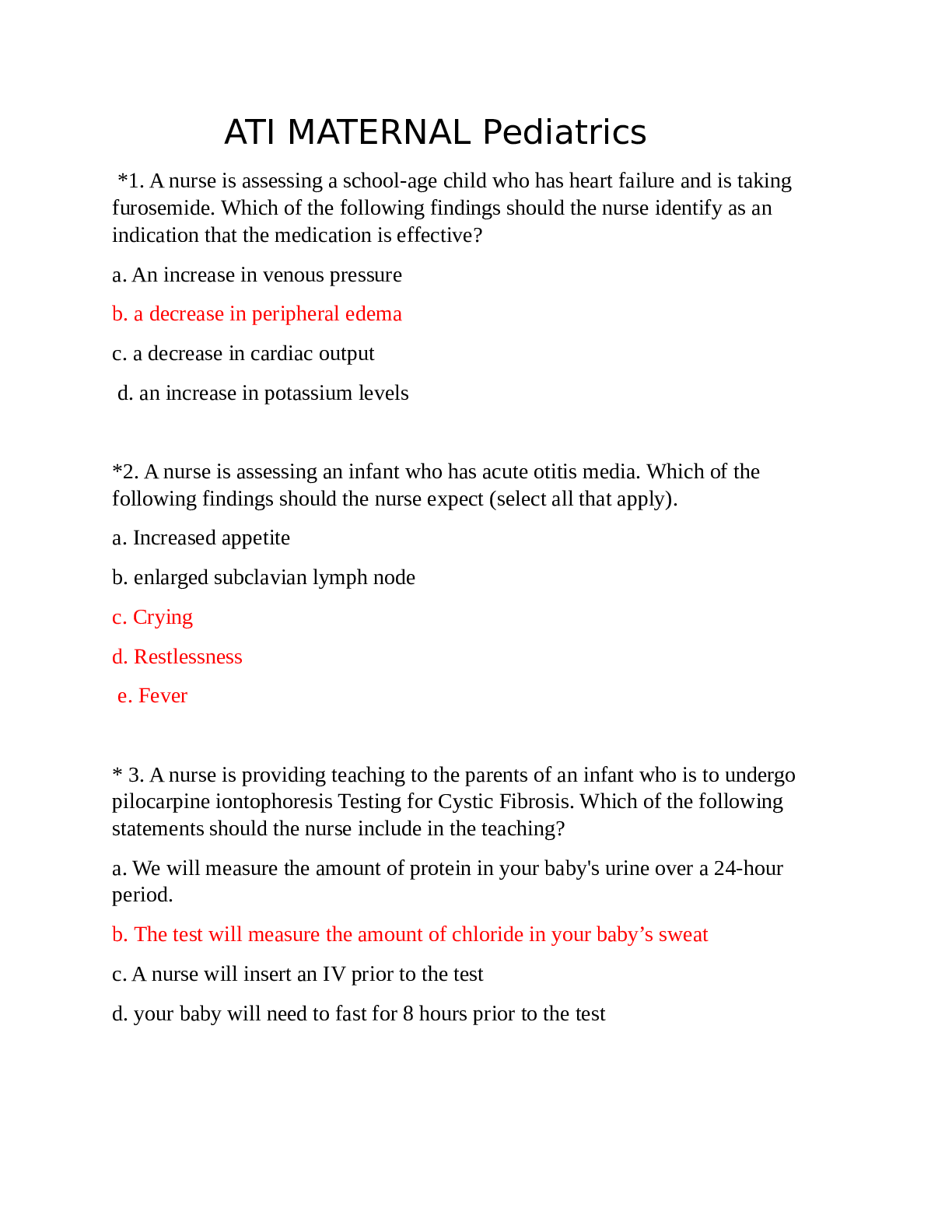











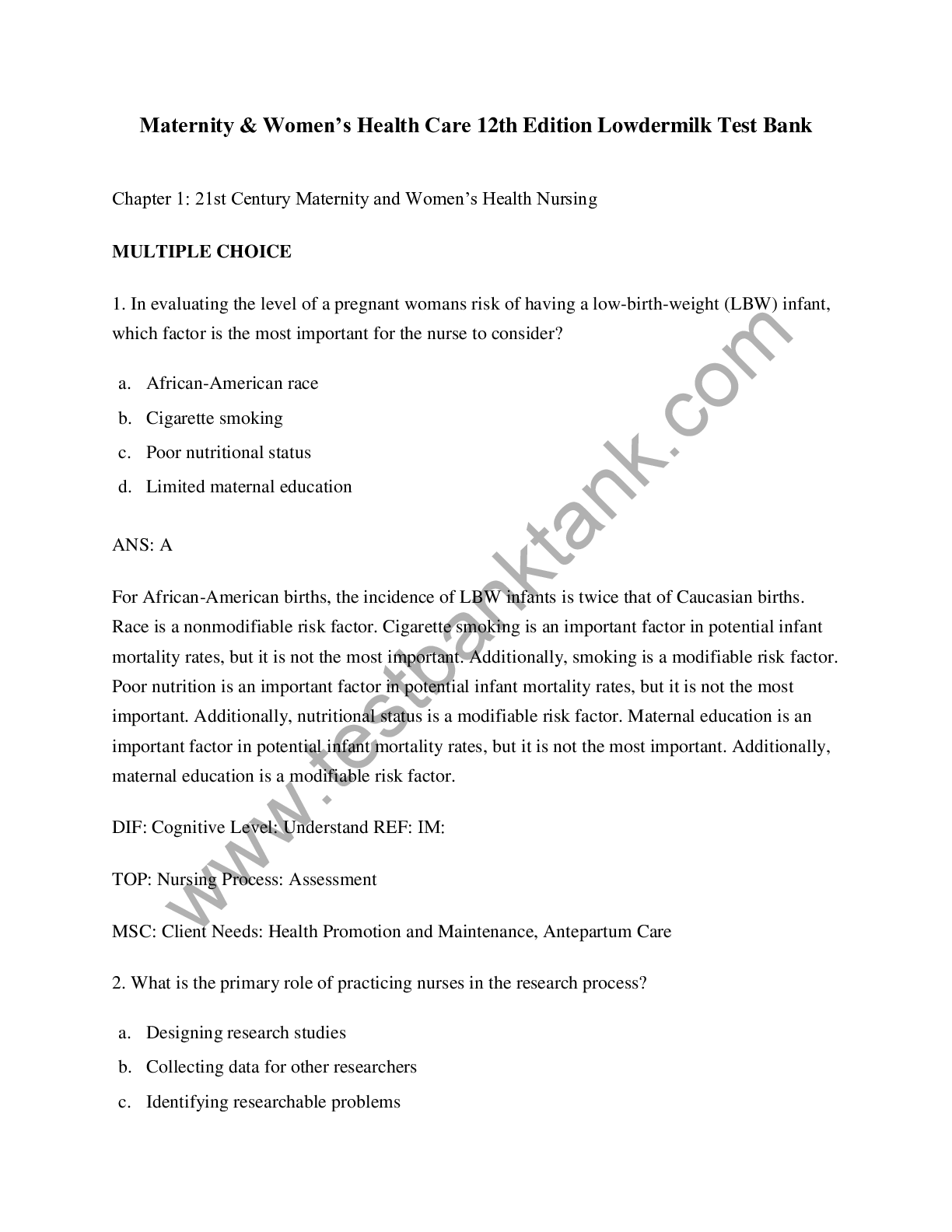

.png)
.png)
